STUDENTS PROJECTS
2010
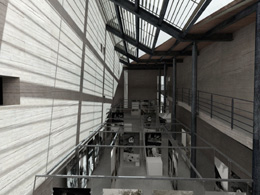
17 July, 2010
Small mining museum and centre of environmental research in Itea.
A basic synthetic component was the topography of the land.
Students Anagnostakis Georgios, Koumantou Chrysoula
Professor: Tsiraki Sofia, Lecturer of Design & Theory
Consultant: Tsouras Vasilis, Lecturer of Architectural Technology
National Technical University of Athens, March 2010
Short description
This diploma project concerns the study of a small museum dedicated in the mining history of region Gkiona. It is placed in the gulf of Itea, in the abandoned installations of treatment and transshipment of Bauxite.
The museum is drawn based on the logic of small local thematic museums and is constituted by three parts: The museum centre dedicated in the environmental study and a lecture space.
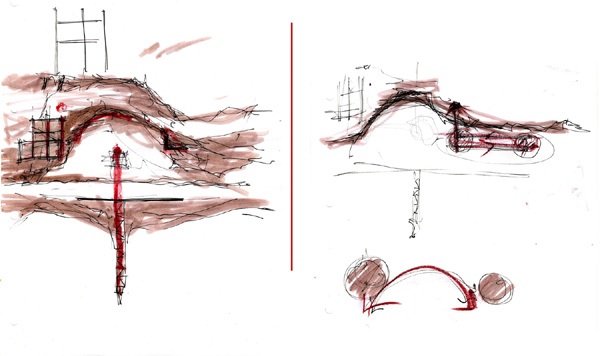
Sketch of region and idea
Text
This diploma project concerns the study of a small museum dedicated in the mining history of region Gkiona. It is placed in the gulf of Itea, in the abandoned installations of treatment and transshipment of Bauxite.
The building is drawn based on the logic of small local thematic museums that are manufactured in the place where their exhibits are found. That is how the forecourt is being exploited as part of the place. It simultaneously touches upon the hyper-topic level while having a research and educational character.
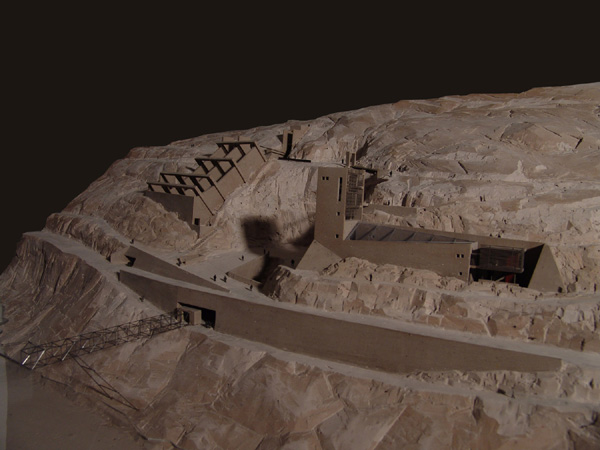
Model, building - existing construction (behind) - crane
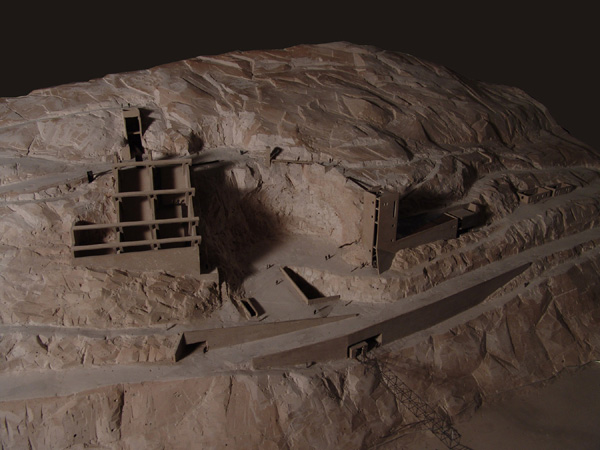
Model, construction - excavation and mountain paths
The building is a complex that is constituted by three parts.
- The museum that includes a reception, a gift shop and a small cafe.
- A centre dedicated in the study of environmental repercussions and methods of re-establishment after the mining activity in which is forecasted a small complex of hostels for students and researchers mineralogists.
- And a lecture space.
The choice as far as the uses of the complex are concerned was studied based on the needs of the region and is related with the environmental re-establishment. It is also connected with the relation that could be developed between the place, the residents and the mining activity which renders the place ¨rich¨ in industrial history places.
Emphasis is given in the way of intervention that is connected with the human made landscape of mines of bauxite. A basic synthetic component was the topography of the land. Thus we tried to determine and redefine the relation between building and person with the continuously evolving environment of mines.
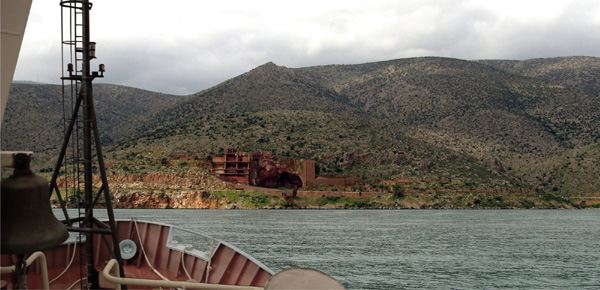
Photorealistic depiction by the sea, the building and the elements that compose landscape
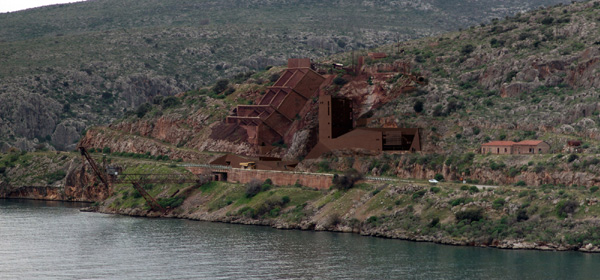
Photorealistic depiction, ¨the old and the new¨
The vocabulary by which the building of museum was drawn originated from the industrial installations. Consequently the basic elements of place (construction, excavation, crane) were evaluated and mountain trails were taken into consideration. The excavation isn't suspended and is considered as a completed stroke of the pen. The central space that is created by the excavation is selected as a basic core of solution, while the building volume is condensed in a specific point at the end of the excavation as the minimal possible intervention. The location of the museum at the end of the intense curve that is created by the excavation, places the composition in an intermediary point, where on one side the interaction with the basic structural elements of place is possible and on the other the integrity of rock is maintained. That is how an explicit segregation is done between the built - human made space and the natural landscape. The place of the museum presents a contrapuntal relation with the large scale construction of desiccation, while the intermediary space of the excavation functions as conjunctive element between ¨the old and the new¨.
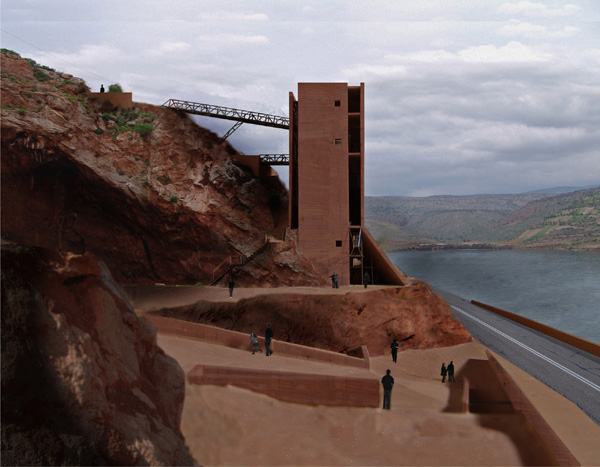
Photorealistic depiction, the central landscape - distribution of movements
The composition is completed between two support walls, a slot in the ground that creates a horizontal axis. Via these, a relation between the space of museum and the rock is created, attributing the sense of galleries. Consequently a variety is presented regarding the qualities of exhibition but also the natural lighting that enters this space. The spiral ascendant movement defines a course which exceeds the limits of walls and enriches the experience of the visitor.
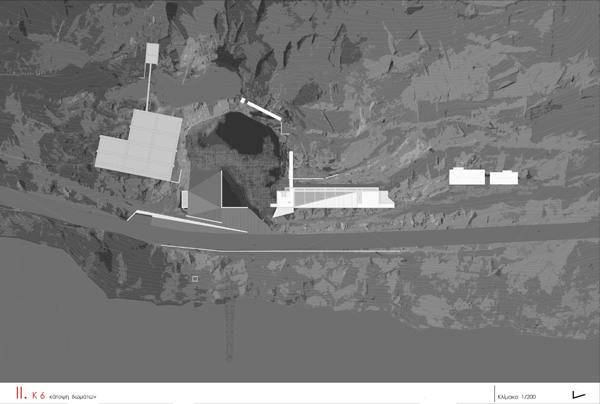
Plan
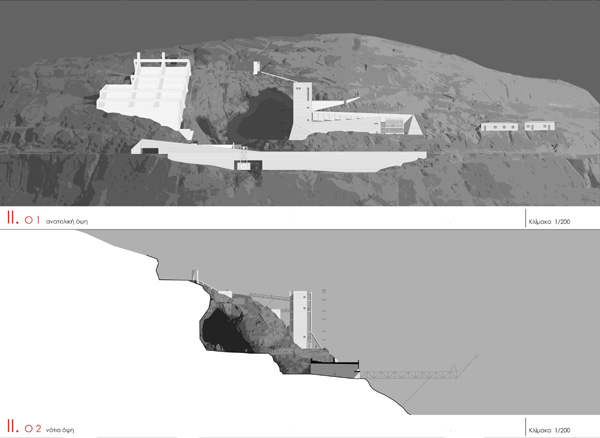
View from the sea and view of entry with section in the terrain
The two support walls are growing to a height, creating the tower and importing the vertical axis. The building of the museum receives the movements through its outdoor while the two main axes vertical and horizontal, divide them via the spiral course.
The choices regarding the materials are also influenced by the region and the mining activity, thus metal and rough concrete are used.
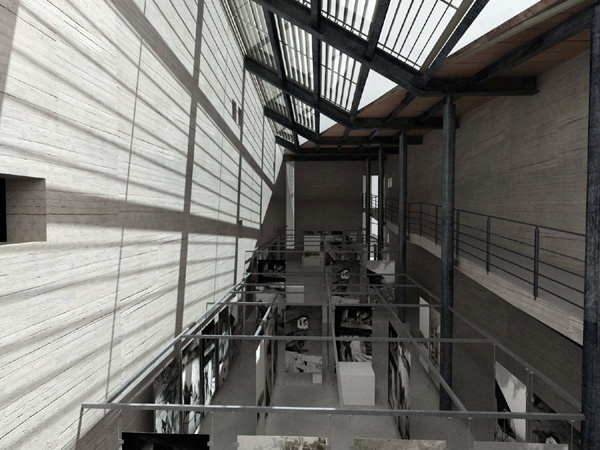
3d depiction, internal view of exhibition space
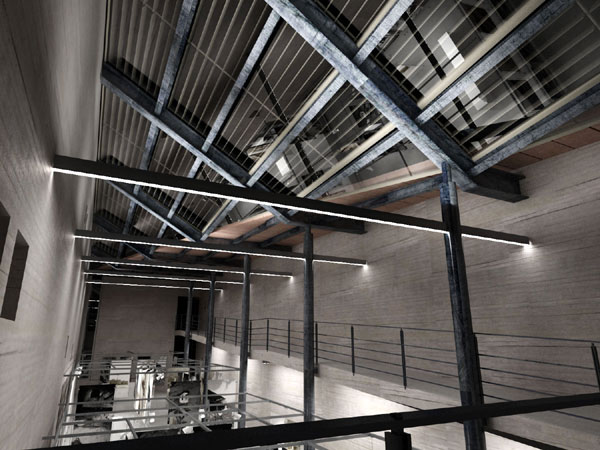
3d depiction, night view of the exhibition and the roof
Related articles:
- UNDERGROUND MUSEUM IN PALIOURI DIMINIOU OF PHYSICAL DISCIPLINE AND BODY INCARCERATION ( 26 August, 2007 )
- Moderna Museet Malmö ( 10 May, 2010 )
- NEW PATRAS MUSEUM ( 12 October, 2009 )
- NATIONAL RESISTANCE MUSEUM AND MONUMENT TO ELECTRA APOSTOLOU IN NEON HERAKLEION, ATHENS ( 19 October, 2009 )
- 3rd Prize for a Greek entry in an international architectural competition ( 20 September, 2010 )
- ATHENS COMICS MUSEUM at Gkazi ( 10 February, 2011 )
- Costume Culture Museum ( 10 February, 2011 )
- Stone Bridge Museum ( 18 September, 2012 )
- “Urban intervention network in Plato’s Academy_A Museum of the city of Athens proposal” ( 10 April, 2011 )
- Transformation of the warehouse of tobacco Papapetrou in an Archeological museum of Aitoloakarnanias and cultural centre of Agrinio ( 08 May, 2011 )
- Los Angeles Museum of the Holocaust ( 15 June, 2011 )
- Archaeological Museum of Arta ( 12 August, 2013 )
- "Earth Museum" ( 05 January, 2012 )
- Venetian Arsnals of Chania ( 24 January, 2012 )
- New Taipei City Museum of Art, Conceptual Design International Competition August 2011 ( 08 February, 2012 )
- Mining Museum in Serifos ( 15 February, 2012 )
- Riverside Clubhouse ( 10 March, 2012 )
- New Glasgow Riverside Museum of Transport ( 24 April, 2012 )
- Enzo Ferrari Museum ( 23 April, 2012 )
- Bunker 599 603 ( 06 May, 2012 )
- Heidelberg Castle’s new Visitor Center ( 24 May, 2012 )
- Grand Egyptian Museum in Cairo ( 22 January, 2013 )
- Guggenheim Museum in Helsinki ( 22 March, 2013 )
- Noesis. Interactive Museum ( 20 May, 2013 )
- Danish National Maritime Museum ( 28 November, 2013 )
- Redefining Leftovers ( 05 April, 2014 )
- Cultural center of Glyfada ( 23 February, 2014 )
- The rack railway museum at Vouraikos gorge ( 18 April, 2014 )
- Historical and Folklore Museum of Nikiti ( 17 February, 2017 )










